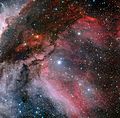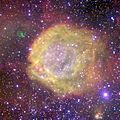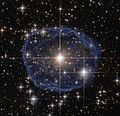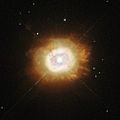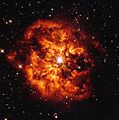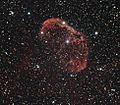Wolf–Rayet star facts for kids
Wolf–Rayet stars (often called WR stars) are very old and super big stars. They start out being more than 20 times heavier than our own Sun! These stars are special because they lose a lot of their material very quickly.
Imagine a strong wind blowing from the star. This "stellar wind" can be super fast, up to 2,000 kilometers per second! To give you an idea, our Sun loses a tiny bit of its mass each year, like a speck of dust. But Wolf–Rayet stars lose a huge amount, about 100 million times more mass than the Sun every year.
Wolf–Rayet stars are also incredibly hot. Their surfaces can be between 30,000 K and 200,000 K (that's Kelvin, a way to measure temperature). Because they are so hot, they look blue. They also shine with a lot of energy, much more than the Sun – sometimes millions of times brighter! However, you might not see them as super bright with your eyes because most of their light is in invisible forms, like ultraviolet light and even X-rays.
Contents
What is Star Brightness?
When we talk about how bright a star is, there are a few ways to think about it.
How Much Energy a Star Gives Off
In astronomy, luminosity is a fancy word for the total amount of energy a star or other space object gives off. Think of it like a light bulb's power, measured in watts. Our Sun, for example, gives off a huge amount of energy, which we call 1 solar luminosity. This is the basic way scientists measure how powerful a star is.
How Bright a Star Looks
Apparent magnitude is how bright a star looks to us from Earth. This depends on how much light it gives off and how far away it is. A very bright star far away might look dimmer than a less bright star that is closer.
Absolute magnitude is different. It tells us how bright a star truly is, no matter how far away it is from us. It's like comparing all stars from the same distance.
Images for kids
-
WR 22 in the beautiful Carina Nebula.
-
AB7 creates one of the brightest glowing clouds in the Magellanic Clouds.
See also
 In Spanish: Estrella de Wolf-Rayet para niños
In Spanish: Estrella de Wolf-Rayet para niños




